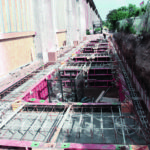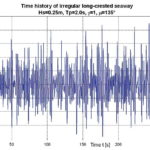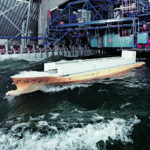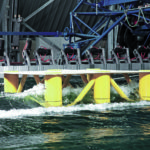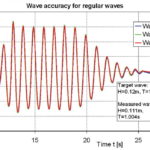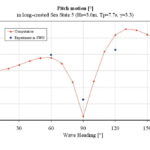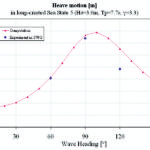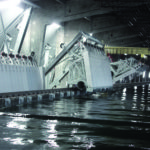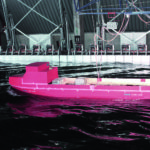Due to new standards and increasing requirements on safety as well as economic aspects of ships in seaways it is essential for modern model basins to be prepared for changing demands.
With the new side wave generator (SWG) the Hamburg Ship Model Basin HSVA (Hamburgische Schiffbau-Versuchsanstalt) increases its seakeeping test[ds_preview] facilities dramatically. With the aim to acquire new markets and thus new orders the HSVA extends as first model basin worldwide its towing tank with a new computer controlled side wave generator in order to investigate seagoing ships in realistic sea scenarios.
In January 2008, the HSVA started the project »ViTa-II« for the generation of beam and oblique waves in its large towing tank. The project is partially funded by the Free and Hanseatic City of Hamburg. After two years of intensive planning, designing, engineering and manufacturing the new side wave generator (SWG) is now installed and has just commenced operation.
Together with Bosch Rexroth, a leading company in manufacturing wave generation systems, a feasibility study was carried out in order to meet the special requirements when installing a side wave generator in an existing ship model basin. The most restricting factors – very limited space and no influence on other tests – led finally to the concept of a retractable wave generator, which can be stored in the walkway beside the towing tank. By means of a dedicated stowage system the SWG is transferred from stowage into operation mode within less than half an hour.
In order to realize the concept of a retractable side wave generator it was inevitable to extend the building for providing the necessary space for erecting the stowage system and storing the Side Wave Generator. In Figure 1.1 the huge skeleton of the 18 m deep pile foundation can be seen – strong enough to withstand the cyclic loads and the weight of the stored SWG without displacements. Once the foundation was ready the extension building of the towing tank was raised. With the erected stowage system the installation of the side wave generator started (Figure 1.2). Each of the five sections was transported by the internal towing tank crane to its final position on the wall hooks. From this position the sections were picked up by the stowage system and placed at their stowage position (Fig. 1.3). During all construction and installation work normal model testing operations went on. Only during the commissioning phase the tank was closed for a short period in order to adjust and calibrate the system properly.
The new SWG is a snake wave generator consisting of 80 flaps each having the width of 0.5 m (Fig. 2). The 80 flaps are arranged on five single sections. Each flap is controlled individually; therefore arbitrary waves and sea states can be generated:
• regular waves;
• multichromatic waves with limited number of frequencies;
• irregular long-crested seaways (JONSWAP, PM, TMA and user-defined spectra);
• selected subseries of irregular sea states satisfying given parameters (e. g. steepness);
• irregular short-crested sea states;
• user-defined wave trains.
• The above described waves and seaways can be generated within an angle from 20° to 160°, i.e. enabling investigations in beam and in oblique sea states.
• Together with the existing wave generator, which can generate long-crested waves in the longitudinal tank direction, the combination of wind seas and swell can be simulated.
The side wave generator is mounted in the middle of the long side of the tank wall of the large towing tank of HSVA. Thus, the acceleration and deceleration phases of the ship model take place outside of the actual measuring region and the complete length of the SWG can entirely be exploited for the measurements.
During downtime, the wave generator is stowed out of the towing tank. This was a requirement to the SWG in order to avoid imposing any spatial limitations to other tests such as propulsion or manoeuvring tests.
On the opposite tank wall, facing the side wave generator, a wave absorber is installed, consisting of five rows of 2 m deep vertically positioned steel plates of decreasing porosity. The purpose of the wave absorber is to damp away the incoming waves and thus to minimise wave reflections from the tank wall to the measuring area. These reflections could disturb the generated original wave spectrum. The absorbers remain permanently in the tank, but can be folded to the tank wall outside the operating periods in order to maintain HSVA’s large towing tank original width and thus not to disturb other types of model tests.
The first tests for wave performance showed very promising results (Fig. 3). The spectral shape of an irregular long-crested wave with a significant wave height of 0.25 m and a peak period of 2 s was met with less than 3 % of deviation after the first approach. The straightness of oblique waves of 135° heading was tested with three wave probes aligned in this direction. The result was convincing: absolutely no phase shift was measured (Fig. 3, bottom).
Figure 4 shows the results for the heave, pitch and roll motion of the freely running model in oblique irregular long-crested seas gained from a model test with the SWG compared to the results gained from numerical calculations. Figures 5 and 6 show some typical scenarios and the capability of the new side wave generator in heavy seas.
With the new facility extension highly realistic environment conditions can now be realized in the towing tank to further improve and analyze the seakeeping performance of ships and offshore structures for the benefit of the HSVA customers.
Author:
Dr. Katja Jacobsen
Hamburgische Schiffbau-Versuchsanstalt
Dr. Katja Jacobsen






